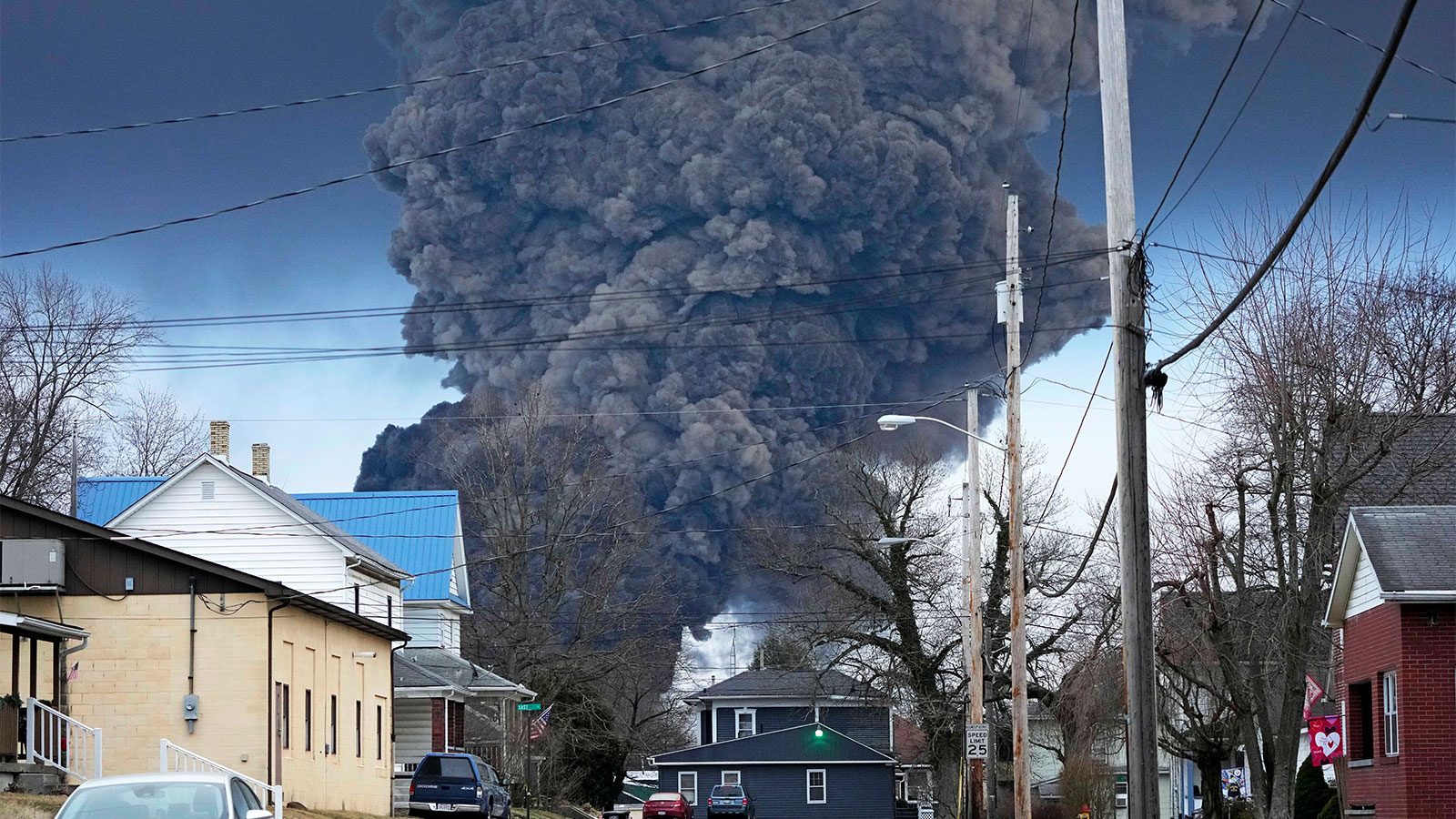Toxic Chemical Residue In Buildings Months After Ohio Train Disaster

Table of Contents
The Persistence of Toxic Chemicals
The February 2023 derailment released a cocktail of hazardous substances, including vinyl chloride, butyl acrylate, and ethylene glycol monobutyl ether. These chemicals, known for their acute and chronic toxicity, pose significant long-term risks. Their persistence in the environment and their potential to accumulate in building materials is a major concern.
- Volatility and Persistence: Vinyl chloride, for instance, is a volatile organic compound (VOC) that can readily evaporate. However, other chemicals, like butyl acrylate, can adhere to surfaces and persist in building materials such as wood, drywall, and insulation for extended periods. The porous nature of these materials allows for absorption and slow release of the chemicals, creating a long-term source of exposure.
- Long-Term Contamination Studies: While immediate post-disaster testing focused on high concentrations, the potential for long-term low-level contamination remains largely unexplored. Further research is crucial to understand the long-term leaching and off-gassing of these chemicals from building materials. The lack of comprehensive studies raises serious questions about the full extent of the contamination.
- Detection Challenges: Detecting low levels of toxic chemical residue presents significant analytical challenges. Specialized equipment and techniques are necessary for accurate measurement, particularly for volatile and semi-volatile organic compounds. This necessitates investment in advanced analytical capabilities to fully assess the extent of the contamination.
Health Concerns for Residents and Workers
Exposure to toxic chemical residue from the derailment poses substantial health risks to residents and workers in the affected areas. The consequences can range from short-term to long-term health problems.
- Specific Health Impacts: Vinyl chloride is a known carcinogen linked to various cancers, including liver, lung, and brain cancer. Butyl acrylate can cause respiratory irritation, skin sensitization, and eye damage. Exposure to ethylene glycol monobutyl ether can lead to kidney and liver damage.
- Vulnerable Populations: Children, the elderly, and individuals with pre-existing respiratory or immune conditions are particularly vulnerable to the health effects of these chemicals. Their developing or compromised systems are more susceptible to damage from even low-level exposure to toxic chemical residue.
- Causation Challenges: Establishing a direct causal link between exposure to specific chemicals and health problems in this complex situation will be difficult. However, careful epidemiological studies are needed to monitor the health of the affected population and identify any correlations.
The Need for Comprehensive Testing and Remediation
Current efforts to assess and remediate the contamination are insufficient. A comprehensive and independent approach is urgently required.
- Independent Third-Party Testing: Independent, third-party testing of all potentially affected buildings is essential to determine the extent of the toxic chemical residue contamination. This ensures objective results and avoids potential conflicts of interest.
- Effective Remediation Steps: Effective remediation requires a multi-pronged approach including decontamination of surfaces, removal and disposal of contaminated materials according to EPA guidelines, and air quality monitoring. This may involve demolition and reconstruction in severely affected areas.
- Financial and Logistical Challenges: The financial and logistical challenges of large-scale remediation are substantial. Governmental support and funding mechanisms are critical for ensuring that affected communities can access the resources needed for thorough cleanup.
Governmental Response and Accountability
The response of local, state, and federal governments to the lingering threat of toxic chemical residue has been criticized by many.
- Regulatory Effectiveness: The existing regulations and policies may need review to ensure adequate protection from similar incidents in the future. There's a need for a more comprehensive framework for handling hazardous material transportation and emergency responses.
- Response Deficiencies: Critics point to delays in testing, communication gaps with affected communities, and a lack of transparency in the decision-making process. These shortcomings have eroded public trust and heightened concerns about long-term health and environmental consequences.
- Increased Transparency and Accountability: Enhanced transparency and accountability mechanisms are crucial for restoring public trust and ensuring a more effective response to future incidents. This involves open access to testing results, public forums for discussion, and independent oversight of remediation efforts.
Long-Term Environmental Impact
The long-term environmental consequences of the derailment extend beyond building structures.
- Soil and Water Contamination: The released chemicals could contaminate soil and water resources, potentially affecting drinking water supplies and agricultural lands for years to come.
- Wildlife and Ecosystem Risks: Exposure to toxic chemical residue poses risks to wildlife and the overall health of the ecosystem. Long-term monitoring of wildlife populations and aquatic life is needed to assess the extent of the impact.
- Ongoing Environmental Monitoring: Continuous environmental monitoring is crucial to track the spread and persistence of contamination, informing remediation strategies and guiding the long-term management of the affected area.
Conclusion
The lingering presence of toxic chemical residue in buildings months after the Ohio train disaster underscores the devastating long-term consequences of this environmental catastrophe. Comprehensive testing, transparent government action, and effective remediation efforts are crucial to protect the health of residents and the environment. We must demand accountability and ensure that all affected communities receive the support they need to address the ongoing threat of toxic chemical residue and prevent future disasters. Demand answers and action regarding the toxic chemical residue in your community – your health and the health of future generations depend on it.

Featured Posts
-
 Philips Annual General Meeting Of Shareholders Key Highlights
May 24, 2025
Philips Annual General Meeting Of Shareholders Key Highlights
May 24, 2025 -
 Pre Owned Porsche 911 S T Pts Riviera Blue Detailed Specifications
May 24, 2025
Pre Owned Porsche 911 S T Pts Riviera Blue Detailed Specifications
May 24, 2025 -
 Horoscopo De La Semana Del 4 Al 10 De Marzo De 2025 Predicciones Para Todos Los Signos
May 24, 2025
Horoscopo De La Semana Del 4 Al 10 De Marzo De 2025 Predicciones Para Todos Los Signos
May 24, 2025 -
 Sharp Decline In Amsterdam Stock Market 7 Drop At Opening
May 24, 2025
Sharp Decline In Amsterdam Stock Market 7 Drop At Opening
May 24, 2025 -
 Promoting Growth Through Collaboration The 2nd Best Of Bangladesh In Europe
May 24, 2025
Promoting Growth Through Collaboration The 2nd Best Of Bangladesh In Europe
May 24, 2025
Latest Posts
-
 The Ultimate Dc Legends Of Tomorrow Walkthrough
May 24, 2025
The Ultimate Dc Legends Of Tomorrow Walkthrough
May 24, 2025 -
 Dc Legends Of Tomorrow Team Building And Synergies Explained
May 24, 2025
Dc Legends Of Tomorrow Team Building And Synergies Explained
May 24, 2025 -
 Mastering Dc Legends Of Tomorrow Tips And Tricks For Success
May 24, 2025
Mastering Dc Legends Of Tomorrow Tips And Tricks For Success
May 24, 2025 -
 Wrestle Mania 41 Golden Championship Belts And Tickets Memorial Day Weekend Sale
May 24, 2025
Wrestle Mania 41 Golden Championship Belts And Tickets Memorial Day Weekend Sale
May 24, 2025 -
 Wwe Wrestle Mania 41 Secure Your Tickets This Memorial Day Weekend Championship Belts Available
May 24, 2025
Wwe Wrestle Mania 41 Secure Your Tickets This Memorial Day Weekend Championship Belts Available
May 24, 2025
